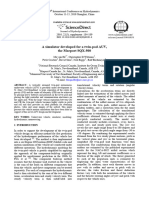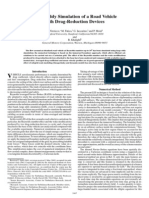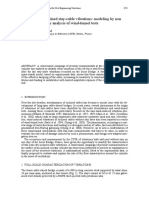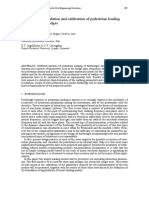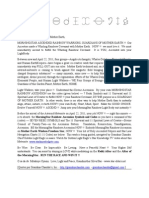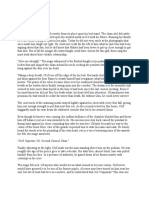CD Paper Pag 227
CD Paper Pag 227
Uploaded by
Anonymous lEBdswQXmxCopyright:
Available Formats
CD Paper Pag 227
CD Paper Pag 227
Uploaded by
Anonymous lEBdswQXmxOriginal Description:
Copyright
Available Formats
Share this document
Did you find this document useful?
Is this content inappropriate?
Copyright:
Available Formats
CD Paper Pag 227
CD Paper Pag 227
Uploaded by
Anonymous lEBdswQXmxCopyright:
Available Formats
Experimental Vibration Analysis for Civil Engineering Structures
227
Multiple vehicle axle load identification from dynamic bridge
response: An experimental study
P. Asnachinda & T. Pinkaew
Department of Civil Engineering, Chulalongkorn University, Bangkok, Thailand
J. A. Laman
Department of Civil and Environmental Engineering, Pennsylvania State University, Pennsylvania, USA
ABSTRACT: The identification of multiple vehicle dynamic axle loads on a model, multi-span,
continuous bridge is presented. The objective of the present study was to develop a practical
technique to determine dynamic axle loads of multiple vehicles based on measured response. To
simulate vehicle-bridge interaction and collect dynamic response data, a scaled model of a
three-span, continuous bridge and two scaled 2-axle vehicles were designed, constructed and
fabricated in the laboratory. Using bridge dynamic response as the input, the unknown axle
loads were identified which correspond to the inverse problem of gaining load from response.
The inverse problem was solved using an optimization method based on the least square with
regularization. The accuracy of the identified solutions is effectively improved by using an updated static component (USC) technique, particularly around the internal supports of the continuous bridge. Because each vehicle travels over the bridge independently, the effect of several
truck traveling schemes between the two vehicles was considered. The effectiveness and reliability of axle load identification from different moving schemes of multiple vehicles are studied and discussed. The obtained experimental results show that axle load identification through
the USC regularization is robust and provides very good estimates of axle loads of both vehicle
axle loads. It was also observed that the proposed method can accurately identify the multiple
axle loads for all moving schemes of vehicles. The accuracy of identified axle loads for all cases
of study is within 10%.
1 INTRODUCTION
The static and dynamic axle load of heavy weight vehicles is an important parameter for design
and evaluation of bridges and pavements, design code calibration, bridge rating and fatigue assessments. Although several existing truck weighing methodologies are available, such as
weigh-in-motion (WIM), government weigh station scales, and turnpike gates, the obtained
weights are limited to static axle loads or gross vehicle weight. Moreover, extended samples of
actual dynamic vehicle/bridge interaction forces are not practically available because the measurements are limited to instrumented vehicles. To monitor and collect both static and dynamic
axle loading data, an identification system has been developed to determine the time histories of
vehicle axle loads from bridge response.
Several early numerical methods were proposed in the late 1990s to identify dynamic moving
forces using bridge response measurements such as strains, bending moments, displacements or
accelerations. A method employing modal superposition to solve a set of differential equations
by convolution in the time domain (Law et al. 1997) is an early effort to solve this problem. Improving on this technique, Law, et al (1999) proposed a frequency time domain method that performs a Fourier transformation of the load-response relationship and identifies axle loads directly using least squares. Chan et al (1999) proposed an interpretive method employing a closeform solution by solving the bridge uncoupled equation of motion in modal coordinates. The
228
EVACES07
approaches taken by Law and Chan compute the inverse of the structural transformation matrix
that generally results in ill-conditioning due to rank deficiencies which can require extensive
computational time.
Later, numerous improvements to early attempts at dynamic axle load identification were
proposed. Law and Zhu (2002) suggested improvements in dynamic axle load identification by
using a regularization technique in the least squares optimization process. The smoothing, or
regularization, is added to the residual error of an objective function in order to avoid illconditioning because the matrix becomes nonsingular. Regularization results in a bounding of
the solution within the appropriate range without large fluctuations. However, it is very difficult
to determine the most appropriate value of the regularization parameter due to the parameter being very sensitive to the physical properties of vehicles and bridges, measurement information,
and the moving configuration of vehicles. Yu and Chan (2002) introduced singular value decomposition (SVD) to overcome matrix singularity. For SVD, the regularization parameter is
not required; however, although the results are robust, the solution returns large initial and final
calculated axle load fluctuations which do not correspond to the actual axle loads. To overcome
this fluctuation, an updated static component (USC) technique was proposed by Pinkaew
(2006). The USC technique decomposes the axle forces as static and dynamic components and
repetitively analyzes the decomposed dynamic component until convergence is obtained. With
this iterative approach, the accuracy of the identified results is improved and always rounds up
toward the static influence lines. The USC solution indicates that the initial and final stage large
fluctuation problem due to discontinuities of the boundary conditions as found in the conventional identification methods is eliminated. Moreover, the regularization parameter can be assigned within a wide range without losing solution accuracy. Based on an experimental study
conducted by Pinkaew and Asnachinda (2007), it was demonstrated that modeling the bridge as
a beam is sufficient when using the average of bending moment measurements derived from
strain gauges located at several positions in the transverse direction. With this procedure, the
bridge torsional effect, which can cause additional computational demands and complexity, vanished. Therefore, the computational time in the dynamic axle load identification is significantly
reduced from that required for a plate model.
Based on a review of numerical studies, methodologies have been proposed to identify axle
loads of a single vehicle. Actual normal traffic consists of frequent multiple presence occurrence
of trucks on a given bridge. Events of side-by-side, closely following, and overtaking between
heavy weight vehicles can be observed and are of considerable importance. In the present study,
a methodology for axle load identification of multiple vehicles is presented. The least squares
regularization through SVD method and USC technique is adopted. The axle loads of each vehicle are identified independently. A scaled experiment with two model vehicles traveling on a
model bridge was conducted using bending strain measurements. The bridge is three-span, continuous with two non-articulated frame vehicles including spring suspensions and rubber tires
were fabricated in the laboratory.
2 MULTIPLE MOVING LOAD IDENTIFICATION FROM BRIDGE RESPONSE
In this section, the theory of moving load identification and the numerical method for accuracy
improvement are presented. The identification is based on the inverse problem of returning
bridge response to point loads via an optimization process. The difficulty of solution from the
conventional method and effectiveness of using the USC technique are also given.
2.1 Bending moments of a bridge under multiple moving loads
Figure 1 presents a finite element model of an n-span continuous bridge subjected to multiple
vehicle axle loads. The bridge is assembled from small beam elements having the same length
of l. The axle loads are moving independently with their velocities subjected to the vehicle
speeds. All unknown axle loads are assumed as time-varying point loads and the bridge is modeled as an n-span continuous beam. The ith moving load is thus represented as Pi ( t ) with respect
229
Experimental Vibration Analysis for Civil Engineering Structures
to its corresponding position xi (t) referred to distance from the left support. The bridge equation
of motion under multiple axle loads can be written as:
&&(t ) + Cu& (t ) + Ku(t ) = H ( x(t ))P (t )
Mu
(1)
where u(t ) denotes bridge response vector, M, C and K are mass, damping and stiffness matrices of the bridge respectively. P (t ) is a vector of unknown moving loads consisting of all axle
load components. H(x(t)) is a global external load shape function used to transform the unknown moving load vector P (t ) to the nodal load of bridge model which can be obtained using
Hermitian cubic interpolation. Using stress-strain relationships, the bending moment at the jth
measurement station, m j, (located at a distance xj from the left support) that is induced by the
axle loads can be calculated as:
m j ( j , t ) =
EI j
(12 j 6l ) l ( 6 j 4l ) (12 j 6l )
l3
ua (t )
u (t )
l ( 6 j 2l ) b (2)
uc (t )
ud (t )
where ua(t), ub(t), uc(t) and ud(t) are the nodal displacements of the corresponding beam element,
and j is the local location of the measured station with respect to its element as shown in Figure 2. Solving Eq. (1) with state space formulation and combining with Eq. (2), the relationship
between the predicted sectional bending moments and nodal displacements of the bridge is obtained as:
T
m 2 L m j } =QX
= {m
Z
1
(3)
is the predicted bending moment matrix containing the set of predicted sectional bendwhere Z
ing moment vectors according to time t, and Q is a transformation matrix used to transform the
consisting of nodal displacepredicted bending moments into the predicted state variable X
ments and velocities.
P1 (t)
x1 (t)
P2 (t)
x2 (t)
Pi (t)
xi (t)
xN (t)
PN (t)
EI1 , 1 , A1
L1
EI 2 , 2 , A2
L2
EI n , n , An
Ln
EI j , j , Aj
Lj
L
Figure 1. An n-span continuous bridge subjected to multiple moving loads.
P4 (t )
P2 (t )
S2
P3 (t )
S1
ua (t)
uc (t)
ub (t)
l
x4 (t)
x3 (t)
xj
P1 (t )
EI j , A j , j
ud (t)
Node
j (t ), m j ( j , t )
j
l
x2 (t)
x1 (t)
L
Figure 2. Measuring point and nodal displacement in finite beam element.
Node
230
EVACES07
2.2 Dynamic axle loads identification with least squares regularization
To identify dynamic axle loads of multiple vehicles, a least squares method is adopted to determine a solution leading to the least residual error between the measured and the predicted bending moments. An objective function for this problem can be expressed as:
)T ( Z - QX
) + P T P
E = (Z - QX
(4)
where Z is the measured bending moment matrix consisting of measured sectional bending
moments defined as:
Z= {m1
m2 L m j } .
(5)
The P P term in Eq. (4) is a smoothing term or regularization that controls the order by a
constant of regularization parameter, . With an additional term of squared unknown axle loads,
the identified result becomes less sensitive to measurement noise. However, ill-conditioning is
usually observed when the regularization parameter is not an optimal value. Therefore, to avoid
matrix singularity due to rank deficiency, the singular value decomposition (SVD) is adopted to
convert the solution into a discrete form. Using SVD, the transformation matrix Q is decomposed as Q = USV T . U and V are orthogonal matrices, and S is a diagonal matrix containing
singular values. Hence, the solution of axle loads vector, P (t ) can be represented as:
P =
(
k= 1
k
2
k
(u k T Z)v k
+ )
(6)
where N is the rank of matrix Q, k is the singular values contained in matrix S, and u and v are
sub-orthogonal vectors with respect to matrices U and V from decomposition, respectively.
2.3 Accuracy improvement using USC technique
The solution for Eq. (6) demonstrates that the result is very robust relative to ill-conditioning
and measurement noise. Figure 3 shows the algorithm of the USC technique which is employed
to overcome the difficulty for assigning a regularization parameter. With this approach, the difficulty of dynamic load identification near bridge supports due to the weak relationship between
loads and bridge bending moment is also eliminated.
To investigate the accuracy of the results, the identification error is defined as the norm of actual and identified axle loads as the relative percentage error, RPE as
RPE =
Pi Pi
Pi
100%.
(7)
3 LABORATORY TESTING
The experimental study was conducted to investigate the effectiveness and identification accuracy of the proposed method. The scaled bridge and vehicle model designs are based on dynamic characteristics. To accurately model an actual 3-span, 60 m length, continuous bridge, the
fundamental frequency of the scaled model should be the same as the target bridge. Using an
empirical first mode frequency relationship that is a function of bridge span length, L (Chaallal
& Shahawy 1998):
f1 = 82 L0.9
(8)
the first mode frequency of the target bridge is approximately 5.8 Hz. The scaled model bridge
was designed to match this frequency and is presented in Figure 4. The scaled bridge model is
fabricated from steel plate with length, width and thickness equal to 600 cm, 50 cm and 1 cm,
respectively. Properties of the target RC bridge and designed equivalent steel bridge are presented in Table 1.
Experimental Vibration Analysis for Civil Engineering Structures
Measure Z, set , r = 1
(1)
231
Steps of computation for USC technique
(1) Load identification using optimization of Eq. (6).
r
P r , Z
(2) Load decomposition to obtain the static component (quasi-static)
by time-averaging.
(2)
r
s
(3) Calculate the corresponding static strain component.
(3)
( )
r = func P r
Z
s
s
(4) Compute the remaining dynamic strain component.
(4)
r
Z rd = Z Z
s
r = r+1
r
Input Z
d
(5)
r +1
P dr +1 , Z
d
(6)
P = P + P
r +1 = Z
r +Z
r +1
Z
r +1
r
s
r +1
d
(6) Update the identified result from the combination of the previous
and the latest identified result.
(7) Load decomposition to obtain the updated static component
(quasi-static) by time-averaging.
(7)
r +1
s
(8) Determine the rate of convergence of the updated result.
(8)
No
(5) Repeat the load identification using optimization as in step (1)
by inputting only dynamic strain component from step (4).
P sr +1 P sr
P sr
<
Yes
END
Figure 3. Algorithm of updated static component (USC) technique.
Two 2-axle vehicle models with non-articulated frame, spring suspension and rubber tires
were fabricated for the present study. The axle spacing to span ratio (ASSR) of existing 2-axle
trucks ranges from 0.15 to 0.40, therefore an ASSR equal to 0.16 was selected for the model vehicles in order to study the identification of closely spaced vehicles. Model vehicle dimensions
are provided in Figure 4. The model vehicle travel is controlled by aluminum guide rails attached to the model bridge roadway surface. Three guide rails are attached at the transverse
quarter points to allow three different vehicle travel paths. The vehicles are pulled along the
bridge with taut strings, and truck speed is controlled by DC motors.
Bending moments were determined based on measured strain at 9 different sections: L/4, L/2
and 3L/4 in each of the three spans. Five strain gauges are mounted at L/2 and three gauges are
mounted at L/4 and 3L/4. Precision tension-compression load cells are installed on each model
vehicle axle in order to measure vehicle-bridge interaction forces. Two photoelectric sensors are
positioned at each end of the model bridge to measure model vehicle travel duration. In addition, each model vehicle is equipped with white-black optical detection sensors to determine position as a function of time.
Data acquisition is completed with a 48 channel data logger set at a sampling rate of 1024 Hz
for all 41 connected sensors including: 33 strain gauges, 4 load cells, 2 optical sensors and 2
photoelectric sensors.
To remove signal noise, a moving average filtering was adopted as a low pass filter. Data is
re-sampled with a lower sampling rate to reduce the data set size in identification. Normally the
sampling rate is taken as 10 times the 1st mode fundamental frequency of the bridge. However,
the sampling rate must be higher than the spectral frequency of the axle assembly. The model
vehicle axle assembly was measured to be approximately 40 Hz or less. Therefore, the sampling
rate is carried out at 64 Hz which is 1/16 times of the initial acquisition frequency.
232
EVACES07
Photoelectric sensor
Photoelectric sensor
Black-white tape
PLAN VIEW
Photoelectric sensor
Vehicle model
Leading span
Strain gauges
Vehicle model
String
Strain gauges
Strain gauges
Photoelectric sensor
Motor
Trailing span
3@200 = 600 cm
ELEVATION VIEW
L1/4
L1/2
3L1/4
L2/4
L2/2
3L2/4
L3/4
L3/2
3L3/4
STRAIN GAUGE ARRANGEMENT PLAN VIEW
Front axle
Optical sensor
32 cm
Tension-compress load cell
Aluminum guide rail
1 cm
Rear axle
17.5 cm
6 @ 8.33 cm
50 cm
VEHICLE DIMENSIONS
CROSS SECTION
5 Strain gauges at midspan
of all spans,
3 Strain gauges for others
Figure 4. Experimental setup
Table 1. Properties of target RC and designed equivalent steel bridges
Target RC bridge
L = 20:20:20 m
EI = 9.458106 kN-m2
A = 4320 kg/m
NA. = 1.24 m
First five natural frequencies
5.8, 7.4, 10.9, 23.2 and 26.5 Hz
Designed equivalent steel bridge
L = 2.0:2.0:2.0 m
EI = 6,867 kN-m2
= 7850 kg/m3 (steel)
b = 0.5 m, h = 0.01m
First five natural frequencies
5.8, 7.4, 10.9, 23.2 and 26.5 Hz
4 EXPERIMENTAL RESULTS AND DISCUSSION
Axle load identification of different vehicle moving schemes for two vehicle movement including following, overtaking and side by side are discussed. Recommendations for application of
the method to full scale bridge and vehicle axle load identification are also provided.
In order to study multiple axle load identification, two vehicle models were driven along the
bridge in different traffic lanes. The first vehicle and second vehicle travel in the left and right
lanes, respectively. The moving characteristics of each experimental scheme are listed in Table
2. Table 3 presents the identification error of dynamic and equivalent static axle loads from various cases of two vehicle axle load identification. Table 4 presents the correlation coefficients of
identified dynamic axle loads to measured dynamic axle loads.
233
Experimental Vibration Analysis for Civil Engineering Structures
Table 2. Moving characteristics of experimental examples of two vehicle axle load identification
Case
Following (FL-1)
Following (FL-2)
Overtaking (OV-1)
Overtaking (OV-2)
Side by side (SB)
v1 (m/s)
1.4
1.4
0.6
1.0
1.0
v2 (m/s)
1.0
1.0
1.4
1.4
1.0
td (s)
2.1
3.3
2.8
1.4
0
v1 and v2 are moving speed of the 1st and the 2nd vehicle models respectively.
td is time that let the 2nd vehicle moves into the bridge after the 1st vehicle has firstly started moving into the bridge.
Table 3. Relative percentage error, RPE (%) of identified dynamic and static axle loads
Case
FL-1
FL-2
OV-1
OV-2
SB
Relative percentage errors, RPE of dynamic and static axle loads (%)
1st Front axle
1st Rear axle
2nd Front axle
Dynamic Static
Dynamic Static
Dynamic Static
9.61
-6.46
8.28
-6.35
4.86
-0.12
9.70
-6.39
6.67
0.72
4.70
-0.24
5.70
-0.05
4.30
-2.18
6.00
4.73
7.00
4.39
5.00
-0.04
6.54
-3.96
9.39
-5.03
8.34
3.88
9.48
8.94
2nd Rear axle
Dynamic Static
6.93
6.25
7.77
7.26
9.13
8.65
8.19
7.65
5.21
-2.35
Table 4. Correlation coefficients of identified dynamic axle loads
Axle loads
1st Front axle
1st Rear axle
2nd Front axle
2nd Rear axle
Correlation coefficients of dynamic axle loads
FL-1
FL-2
OV-1
0.9900
0.9908
0.9581
0.9859
0.9836
0.9382
0.9882
0.9908
0.9927
0.9868
0.9905
0.9911
OV-2
0.9425
0.9106
0.9879
0.9865
SB
0.9088
0.8858
0.9387
0.9219
4.1 Vehicle with following vehicle
Table 3 and Table 4 present the results of a two vehicle axle load identification. In this scenario,
the first vehicle moves along the bridge with a velocity of 1.4 m/s while the second vehicle
moves behind with a velocity of 1.0 m/s. The axle loads for this vehicle scenario are identified
with good accuracy and are all within 10% for both dynamic and static loads. Moreover, from
the correlation coefficients of identified axle loads, the results are in very good agreement compared to the actual loads.
Figure 5 presents the axle load time-history of the vehicle with following vehicle scenario.
The interval starting time of travel, td was set to approximately 2 seconds for this case. The results exhibit a good match between actual and identified for all axle loads without a significant
fluctuation in accuracy over time or disruption in identification when the vehicles cross over
bridge supports. In addition, the axle loads are consistently identified through the entire bridge
crossing for each axle without distortion that might be expected as a result of the initial bridge
vibration condition.
4.2 Vehicle overtaking vehicle
Figure 6 presents the results of a second, two vehicle axle load identification. In this scenario,
the following vehicle overtakes or passes the lead vehicle by traveling at a higher rate of speed.
It can be observed from Figure 6 and Table 3 that the identified axle loads are within 10% of the
actual dynamic and static axle loads. This indicates that the proposed method can identify axle
loads accurately, even when one vehicle is overtaking another while on the bridge. No conflict
of the identified axle loads during overtaking is observed because the axle loads are identified
independently and controlled by influence lines from the USC algorithm. In addition, correlation coefficients between identified and measured axle loads presented in Table 4 indicate very
good axle load identification.
EVACES07
200
150
125
100
75
50
25
0
0
Front axle load of 2nd vehicle (N)
Rear axle load of 1st vehicle (N)
Actual
Identified
175
8
Actual
Identified
175
150
125
100
75
50
25
0
0
Actual
Identified
175
150
125
100
75
50
25
0
0
Time (s)
200
200
Rear axle load of 2nd vehicle (N)
Front axle load of 1st vehicle (N)
234
Time (s)
200
Actual
Identified
175
150
125
100
75
50
25
0
Time (s)
Time (s)
Actual
Identified
175
150
st
125
100
75
50
25
0
0
Actual
Identified
175
150
125
100
75
50
25
0
0
Time (s)
10
Actual
Identified
175
150
125
100
75
50
25
0
0
Time (s)
200
200
10
nd
nd
Front axle load of 2 vehicle (N)
Rear axle load of 1 vehicle (N)
200
Rear axle load of 2 vehicle (N)
st
Front axle load of 1 vehicle (N)
Figure 5. Identified axle loads of vehicle following vehicle (v1 = 1.4 m/s, v2 = 1.0 m/s and td = 2 s)
10
Time (s)
200
Actual
Identified
175
150
125
100
75
50
25
0
0
10
Time (s)
Figure 6. Identified axle loads of vehicle overtaking vehicle (v1 = 0.6 m/s, v2 = 1.4 m/s and td = 3 s)
4.3 Side by side movement
Figure 7 presents the results of a third, two vehicle axle load identification. In this scenario,
both vehicles move side-by-side at the same speed and location along the entire length of the
bridge. Although the combined vehicle load can be identified as a single, 2-axle vehicle, the independent axle loads of each vehicle are required. Therefore, the method identifies this scenario
as a 2 vehicle, 4-axle configuration. Table 3 data indicates that identification errors for dynamic
and static loads are below 10% for all axle loads. Figure 7 presents identified and actual axle
235
Experimental Vibration Analysis for Civil Engineering Structures
Actual
Identified
175
150
125
100
75
50
25
0
Front axle load of 2nd vehicle (N)
Rear axle load of 1st vehicle (N)
200
Actual
Identified
175
150
125
100
75
50
25
0
0
Time (s)
Actual
Identified
175
150
125
100
75
50
25
0
0
Time (s)
200
200
Rear axle load of 2nd vehicle (N)
Front axle load of 1st vehicle (N)
loads of side-by-side travel for two vehicles moving at a speed of 1.0 m/s. It can be observed
from Table 4 that correlation between identified dynamic axle loads and measured for this vehicle scenario is below all other scenarios. The identified front axle loads for both vehicles exhibit
the same time-history shape with a small difference in the median force similar to the identified
rear axle loads of both vehicles. This is because the relative axle positions for both vehicles are
almost the same for the duration of the bridge crossing. Therefore, the identified four axle loads
are very close to the two axle load identification that is separated into four axle loads as average
values for the same axle position. However, multiple vehicles with the same number of axles
and axle spacing are rarely observed in actual traffic. The additional condition that two identically configured vehicles travel across the bridge at the same speed side-by-side is even more
rarely observed. Therefore, the proposed method is generally applicable to actual, normally occurring traffic conditions because the method can usually identify multiple axle loads accurately
if the axle loads do not overlap over the entire bridge crossing.
Time (s)
200
Actual
Identified
175
150
125
100
75
50
25
0
0
Time (s)
Figure 7. Identified axle loads of side by side movement (v1 = v2 = 1.0 m/s and td = 0 s)
In order to determine the effectiveness of the proposed method, a comparison between measured bending moments and bending moments reconstructed from the identified loads was performed. Table 5 presents the correlation between measured and reconstructed bending moments
for all experimental cases. It is observed that the identified axle loads induce a near identical
match of bridge bending moments with a correlation greater than 0.994 for all measuring points.
These coefficients imply that the proposed approach is very effective and can be used in multiple vehicle axle load identification.
Table 5. Correlation coefficients of reconstructed bending moments
Correlation coefficients of bending moments at measuring stations
Measuring
station
FL-1
FL-2
OV-1
OV-2
L1/4
0.9974
0.9960
0.9982
0.9982
L1/2
0.9986
0.9981
0.9990
0.9991
0.9954
0.9943
0.9963
0.9979
3L1/4
L2/4
0.9966
0.9949
0.9988
0.9987
0.9989
0.9988
0.9997
0.9995
L2/2
3L2/4
0.9964
0.9975
0.9983
0.9987
L3/4
0.9959
0.9971
0.9946
0.9987
0.9991
0.9990
0.9995
0.9995
L3/2
3L3/4
0.9983
0.9987
0.9991
0.9993
SB
0.9987
0.9990
0.9984
0.9982
0.9994
0.9977
0.9986
0.9997
0.9994
236
EVACES07
5 CONCLUSIONS
Dynamic and static axle load identification of multiple vehicles from bridge bending strain response is experimentally studied. The actual axle loads of vehicles are directly measured and
used in accuracy evaluation of the proposed method. The model bridge is three-span, continuous
made from steel plate, while the model vehicles are two-axle, non-articulated frame with spring
suspension and rubber tires. During the passage of model vehicles, vehicle axle loads, vehicle
position, and bridge bending strains are simultaneously measured. Based on the inverse problem, the dynamic axle loads of vehicles are determined from optimization via least squares
regularization. The SVD method is adopted in the computation to provide robustness of the solution. Moreover, to improve the accuracy of solutions, the USC technique is employed.
Various vehicle travel scenarios between two model vehicles including following, overtaking
and side-by-side are studied in order to determine the reliability and effectiveness of the proposed method. The identified axle load results reveal that the proposed method provides good
determination of dynamic time histories and static axle loads. The method can identify axle
loads for all cases without significant distortion because axle loads are independently identified,
corresponding to influence lines and the USC algorithm. In addition, the identified axle loads
are continuous along the length of the bridge, including when the vehicles pass bridge supports.
This is a significant improvement to obtain loads without a significant fluctuation in accuracy
over time or disruption in identification when the vehicles cross over bridge supports as has
troubled previous studies on load identification from continuous bridge responses.
From the model study of different vehicles travel scenarios, the obtained results demonstrate
that the proposed method offers a good determination of dynamic axle load time histories. The
identified dynamic axle loads are determined with high accuracy, within relative percentage error of 10% of both static and dynamic axle loads for all vehicle movement scenarios. Moreover,
correlation between identified axle loads and reconstructed bending moments demonstrate that
the approach is very effective. It is expected that the proposed method is applicable to a practical systems designed to accurately identify multiple vehicle axle loads, and also able to be applied in practice.
6 REFERENCES
Chaallal, O. and Shahawy, M. Experimental evaluation of dynamic amplification for evaluation of
bridges performance. Technical report No.ETS.DRSR.98.11 Department of Construction Engineering,
University of Quebec. 1998.
Chan, T.H.T., Law, S.S., Yung, T.H. and Yuan, X.R. An interpretive method for moving force identification. Journal of Sound and Vibration. 219(3), 1999, 503-524.
Law, S.S., Chan, T.H.T. and Zeng, Q.H. Moving force identification: A time domain method. Journal of
Sound and Vibration. 201(1), 1997, 1-22.
Law, S.S., Chan, T.H.T., and Zeng, Q.H. Moving force identification a frequency and time domains
analysis. Journal of Dynamics Systems, Measurement, and Control. 121, 1999, 394-401.
Pinkaew, T. Identification of vehicle axle loads from bridge responses using updated static component
technique. Engineering Structures. 28(11), 2006, 1599-1608.
Pinkaew, T. and Asnachinda, P. Experimental study of the identification of dynamic axle loads of moving
vehicles from the bending moment of bridges. Engineering Structures, Available online at
www.sciencedirect.com, 2007.
Yu, L. and Chan, T.H.T. Moving force identification from bending moment response of bridge. Journal of
Structural Engineering and Mechanics. 14(2), 2002, 151-170.
Zhu, X.Q. and Law, S.S. Moving loads identification through regularization. Journal of Engineering Mechanics ASCE. 128(5), 2002, 989-1000.
You might also like
- Proposal RequirementsDocument3 pagesProposal Requirementsapi-238973671No ratings yet
- FLNG Market Update Stephen Gordon ClarksonsDocument38 pagesFLNG Market Update Stephen Gordon ClarksonsrajasekharboNo ratings yet
- 1 Ijssd Submission Revised 15-10-2020Document23 pages1 Ijssd Submission Revised 15-10-2020n.mordaNo ratings yet
- Determination of Load For Quasi-Static Calculations of Railway Track Stress-Strain StateDocument14 pagesDetermination of Load For Quasi-Static Calculations of Railway Track Stress-Strain StateRadu GenescuNo ratings yet
- The Dynamic Response Analysis of Curved Bridge Under The Moving Load, Ren, Jianying, Liu, XingDocument7 pagesThe Dynamic Response Analysis of Curved Bridge Under The Moving Load, Ren, Jianying, Liu, XingHuda AlrikabiNo ratings yet
- Background To Fatigue Load ModelsDocument11 pagesBackground To Fatigue Load ModelsrwaidaabbasNo ratings yet
- Groundborne Vibrations Due To Trains in TunnelsDocument16 pagesGroundborne Vibrations Due To Trains in TunnelsPedro HenriquesNo ratings yet
- Theoretical Calculation Method For The Transverse Load Distribution of Wide Bridges Considering Torsion and DistortionDocument18 pagesTheoretical Calculation Method For The Transverse Load Distribution of Wide Bridges Considering Torsion and DistortionGerardo Nuñez MirandaNo ratings yet
- 08 Felipe GabaldonDocument24 pages08 Felipe Gabaldonewa1988No ratings yet
- Parameter Identification of Vehicles Movingon Continuous BridgesDocument21 pagesParameter Identification of Vehicles Movingon Continuous BridgesAugusto César Santos PeixotoNo ratings yet
- Computers and Structures: Nan Zhang, He XiaDocument9 pagesComputers and Structures: Nan Zhang, He Xialeo2902No ratings yet
- Numerical Simulation of Structural Behaviour of Transmission TowersDocument16 pagesNumerical Simulation of Structural Behaviour of Transmission TowersKrisnandha RahardianNo ratings yet
- 1997 VBIASCEYauDocument8 pages1997 VBIASCEYauMücahit AtalanNo ratings yet
- iNEW Method For Experimental-Numerical Locomotive Studies Focused On Rail Wear PredictionDocument15 pagesiNEW Method For Experimental-Numerical Locomotive Studies Focused On Rail Wear PredictionQing WuNo ratings yet
- Tower Analysis - More Then A Truss PDFDocument12 pagesTower Analysis - More Then A Truss PDFrichificNo ratings yet
- Simplified Estimation of Train Resistance Parameters: Full Scale Experimental Tests and AnalysisDocument18 pagesSimplified Estimation of Train Resistance Parameters: Full Scale Experimental Tests and AnalysisReyhan AlphaNo ratings yet
- Damage DetectionDocument10 pagesDamage DetectionAlaa ElsisiNo ratings yet
- Fulin Yang, Tao Zheng and Bin Li: Application of Pushover Analysis in Bridge Piers, Yunlei ZhangDocument6 pagesFulin Yang, Tao Zheng and Bin Li: Application of Pushover Analysis in Bridge Piers, Yunlei Zhangoma32No ratings yet
- Experimental Evaluation of The Static and Dynamic Characteristics of An Offshore Crane ModelDocument8 pagesExperimental Evaluation of The Static and Dynamic Characteristics of An Offshore Crane ModelUmanath R PoojaryNo ratings yet
- Shape Optimization of Structures Under Earthquake Loadings: Amirhossein SadoughiDocument12 pagesShape Optimization of Structures Under Earthquake Loadings: Amirhossein SadoughiBianca CalugaruNo ratings yet
- Monitoring Bridge Dynamic Behaviour Using An Instrumented Two Axle Vehicle P.J. Mcgetrick, A. González & E.J.ObrienDocument8 pagesMonitoring Bridge Dynamic Behaviour Using An Instrumented Two Axle Vehicle P.J. Mcgetrick, A. González & E.J.ObrienArturo GonzalezNo ratings yet
- Predicting and Measuring Vertical Track Displacements On Soft SubgradesDocument8 pagesPredicting and Measuring Vertical Track Displacements On Soft Subgradesjoelrive10No ratings yet
- Handling Uncertainties in Optimal Design of Suspension Bridges With Special Emphasis On LoadDocument6 pagesHandling Uncertainties in Optimal Design of Suspension Bridges With Special Emphasis On LoadlucasgambiNo ratings yet
- Track Modulus 2Document7 pagesTrack Modulus 2Marius DiaconuNo ratings yet
- Kobe University Repository: KernelDocument27 pagesKobe University Repository: KernelTrầmLãngNo ratings yet
- An Analytical Technique For The Seismic Response Assessment of Slender Bridge PiersDocument16 pagesAn Analytical Technique For The Seismic Response Assessment of Slender Bridge PiersGelica CruzNo ratings yet
- Impact Factors On Short Span Bridges Due To Multiple Vehicle Presence - BradyDocument10 pagesImpact Factors On Short Span Bridges Due To Multiple Vehicle Presence - BradyaapennsylvaniaNo ratings yet
- Metode Perhitungan Daya DukungDocument14 pagesMetode Perhitungan Daya DukungHandi ThomasNo ratings yet
- Railway2014 A New Predictive ModelDocument13 pagesRailway2014 A New Predictive Modelomar cNo ratings yet
- A Parametric Study of Traffic Load Effects in Medium Span BridgesDocument13 pagesA Parametric Study of Traffic Load Effects in Medium Span BridgesKhalilNo ratings yet
- Reutov 2016Document8 pagesReutov 2016George NabilNo ratings yet
- Matecconf bd2018 02006Document6 pagesMatecconf bd2018 02006George HaileNo ratings yet
- Vehicle-Bridge Interactive Analyses On The Lagoscuro ViaductDocument14 pagesVehicle-Bridge Interactive Analyses On The Lagoscuro ViaductNavid SalamiPargooNo ratings yet
- State Dependent Properties of Rail Pads: Research OnlineDocument9 pagesState Dependent Properties of Rail Pads: Research OnlineMaркo ДеурићNo ratings yet
- Load Rating of Impaired Bridges Using A Dynamic Method: B. Samali, J. Li, K.I. Crews M. Al-DawodDocument10 pagesLoad Rating of Impaired Bridges Using A Dynamic Method: B. Samali, J. Li, K.I. Crews M. Al-DawodCamille Andrea SequitinNo ratings yet
- A Vertical Near-Fault Scenario Earthquakes-Based Generic Simulation Framework For Elastoplastic Seismic Analysis of Light Rail Vehicle-Viaduct SystemDocument26 pagesA Vertical Near-Fault Scenario Earthquakes-Based Generic Simulation Framework For Elastoplastic Seismic Analysis of Light Rail Vehicle-Viaduct SystemjustinhehanuaNo ratings yet
- Research Article: Dynamic Behavior of Tied-Arch Bridges Under The Action of Moving LoadsDocument18 pagesResearch Article: Dynamic Behavior of Tied-Arch Bridges Under The Action of Moving LoadsajdhNo ratings yet
- Noncontact Operational Modal Analysis of Light Poles by Vision-Based Motion-Magnification MethodDocument12 pagesNoncontact Operational Modal Analysis of Light Poles by Vision-Based Motion-Magnification MethodBridge&StructureNo ratings yet
- Vehicle-Bridge Interaction Dynamics and Potential ApplicationsDocument22 pagesVehicle-Bridge Interaction Dynamics and Potential ApplicationsAli Berkcan BoyluNo ratings yet
- Truss Bridge ProjectDocument16 pagesTruss Bridge ProjectChrisYap100% (1)
- Evaluation of Dynamic Vehicle Axle Loads On Bridges With Different Surface ConditionsDocument23 pagesEvaluation of Dynamic Vehicle Axle Loads On Bridges With Different Surface ConditionsBridge&StructureNo ratings yet
- Discretization Considerations in Moving Load Finite Element Beam ModelsDocument16 pagesDiscretization Considerations in Moving Load Finite Element Beam ModelsEugene CommerellNo ratings yet
- Analysis of Rolling Contact Fatigue Damage Initiation at The Wheel-Rail InterfaceDocument9 pagesAnalysis of Rolling Contact Fatigue Damage Initiation at The Wheel-Rail InterfaceVicky MtsNo ratings yet
- Agostinacchio2013 Article ParametricalAnalysisOfTheRailwDocument13 pagesAgostinacchio2013 Article ParametricalAnalysisOfTheRailwSusmita PandaNo ratings yet
- Dynamic Analysis of Bridge Under Vehicle Load Using MATLAB and Evaluation of AASHTO Impact FormulaDocument6 pagesDynamic Analysis of Bridge Under Vehicle Load Using MATLAB and Evaluation of AASHTO Impact FormulaeddieNo ratings yet
- 17 2 099 Errb12p60 PDFDocument12 pages17 2 099 Errb12p60 PDFsivadas .bNo ratings yet
- Monitoring Structural Deterioration of Railway Turnout Systems Via Dynamic Wheel-Rail InteractionDocument6 pagesMonitoring Structural Deterioration of Railway Turnout Systems Via Dynamic Wheel-Rail InteractionJorge PerdigonNo ratings yet
- A Simulator Developed For A Twin-Pod AUV, The Marport SQX-500Document6 pagesA Simulator Developed For A Twin-Pod AUV, The Marport SQX-500huy.tranvugia1305No ratings yet
- Influence of The Primary Suspension Damping - Madalina DumitriuDocument16 pagesInfluence of The Primary Suspension Damping - Madalina DumitriudianaNo ratings yet
- Mai Technical ReportDocument14 pagesMai Technical ReportsweetqistNo ratings yet
- Nonlinear Finite Element Analysis of Latticed Transmission Towers 1993Document11 pagesNonlinear Finite Element Analysis of Latticed Transmission Towers 1993ciscoNo ratings yet
- Biondi Et Al 2005Document11 pagesBiondi Et Al 2005Saymo Wendel de Jesus Peixoto VianaNo ratings yet
- 2011 The Interactive Vibration Behavior I PDFDocument14 pages2011 The Interactive Vibration Behavior I PDFCaroline Cole100% (1)
- Na Et Al 2014 A Novel Method For Bending Stiffness Evaluation of Bus BodyDocument10 pagesNa Et Al 2014 A Novel Method For Bending Stiffness Evaluation of Bus BodyHồ Thanh TùngNo ratings yet
- Application of Probabilistic Models To The Response Analysis of Jack-UpsDocument8 pagesApplication of Probabilistic Models To The Response Analysis of Jack-UpsLTE002No ratings yet
- Aiaa Les Moin-SquarebackDocument9 pagesAiaa Les Moin-SquarebackPrateek JaiswalNo ratings yet
- Iss36 Art2 - 3D Modelling of Train Induced Moving Loads On An EmbankmentDocument6 pagesIss36 Art2 - 3D Modelling of Train Induced Moving Loads On An EmbankmentbrowncasNo ratings yet
- 5wacmge ArtigoDocument14 pages5wacmge ArtigoRajshri sumanNo ratings yet
- Structural Identification of A Cantilevered Truss To Inform Live Load RatingDocument3 pagesStructural Identification of A Cantilevered Truss To Inform Live Load RatingLucas HoodNo ratings yet
- Chiana Full Length Paper - Sanjay TiwariDocument11 pagesChiana Full Length Paper - Sanjay Tiwarisanjaymits2No ratings yet
- Neues verkehrswissenschaftliches Journal - Ausgabe 16: Capacity Research in Urban Rail-Bound Transportation with Special Consideration of Mixed TrafficFrom EverandNeues verkehrswissenschaftliches Journal - Ausgabe 16: Capacity Research in Urban Rail-Bound Transportation with Special Consideration of Mixed TrafficNo ratings yet
- Eecs 2012 217Document202 pagesEecs 2012 217Anonymous lEBdswQXmxNo ratings yet
- CD Paper Pag 363Document10 pagesCD Paper Pag 363Anonymous lEBdswQXmxNo ratings yet
- CD Paper Pag 353Document10 pagesCD Paper Pag 353Anonymous lEBdswQXmxNo ratings yet
- CD Paper Pag 373Document10 pagesCD Paper Pag 373Anonymous lEBdswQXmxNo ratings yet
- CD Paper Pag 337Document10 pagesCD Paper Pag 337Anonymous lEBdswQXmxNo ratings yet
- CD Paper Pag 307Document10 pagesCD Paper Pag 307Anonymous lEBdswQXmxNo ratings yet
- CD Paper Pag 277Document8 pagesCD Paper Pag 277Anonymous lEBdswQXmxNo ratings yet
- CD Paper Pag 285Document10 pagesCD Paper Pag 285Anonymous lEBdswQXmxNo ratings yet
- CD Paper Pag 247Document10 pagesCD Paper Pag 247Anonymous lEBdswQXmxNo ratings yet
- CD Paper Pag 295Document12 pagesCD Paper Pag 295Anonymous lEBdswQXmxNo ratings yet
- CD Paper Pag 189Document10 pagesCD Paper Pag 189Anonymous lEBdswQXmxNo ratings yet
- CD Paper Pag 179Document10 pagesCD Paper Pag 179Anonymous lEBdswQXmxNo ratings yet
- CD Paper Pag 199Document10 pagesCD Paper Pag 199Anonymous lEBdswQXmxNo ratings yet
- CD Paper Pag 113Document10 pagesCD Paper Pag 113Anonymous lEBdswQXmxNo ratings yet
- Flame Photometric Determination of Lithium in Red Kidney Beans, Lentils and Teen Talav WaterDocument3 pagesFlame Photometric Determination of Lithium in Red Kidney Beans, Lentils and Teen Talav WaterInternational Journal of Innovative Science and Research TechnologyNo ratings yet
- GuthrieBasicResearchMethodsRev Ed 2023Document266 pagesGuthrieBasicResearchMethodsRev Ed 20235119No ratings yet
- Topic: MEMORY:: Talk About Your Good Memory in The Hotel or RestaurantDocument4 pagesTopic: MEMORY:: Talk About Your Good Memory in The Hotel or RestaurantThao TruongNo ratings yet
- Beers: Finals-HMELEC 3Document6 pagesBeers: Finals-HMELEC 3CauseNo ratings yet
- RISA Seismic Moment ConnectionsDocument11 pagesRISA Seismic Moment ConnectionsJackNo ratings yet
- People vs. Cheng - People vs. PajenadoDocument3 pagesPeople vs. Cheng - People vs. PajenadoAnne Laraga LuansingNo ratings yet
- Diy IntroductionDocument57 pagesDiy IntroductioncoolNo ratings yet
- Nathan Soderblom.: Ninan Koshy,, (Hong Kong: World StudentDocument4 pagesNathan Soderblom.: Ninan Koshy,, (Hong Kong: World StudentEverything newNo ratings yet
- Amenorrhoea NotesDocument17 pagesAmenorrhoea NotesPrasadNo ratings yet
- IM in MANA-01BC-PRINCIPLES-OF-ORGANIZATION-AND-MANAGEMENT-TITO-GONZAGA #MCP - 073423Document76 pagesIM in MANA-01BC-PRINCIPLES-OF-ORGANIZATION-AND-MANAGEMENT-TITO-GONZAGA #MCP - 073423simonetobeschuvanesNo ratings yet
- Eighth Edition of The AJCC Cancer Staging Manual: Breast CancerDocument3 pagesEighth Edition of The AJCC Cancer Staging Manual: Breast CancerRamona Palalogos100% (1)
- Yulistia Rahmi Putri 19040001 - Reading Report Assessment For Young LearnersDocument5 pagesYulistia Rahmi Putri 19040001 - Reading Report Assessment For Young LearnersYulistia Rahmi PutriNo ratings yet
- Media TrialDocument2 pagesMedia TrialNamita ChaudharyNo ratings yet
- Lab InstructionsDocument2 pagesLab InstructionsmariaNo ratings yet
- Bristlecon E: AboutDocument12 pagesBristlecon E: AboutDiksha KamraNo ratings yet
- Morning Star Rainbow AscensionDocument12 pagesMorning Star Rainbow AscensionCarla Anderson100% (1)
- Brand Valuation 1Document10 pagesBrand Valuation 1Amanda MeitaNo ratings yet
- Subtitles Never Give UpDocument63 pagesSubtitles Never Give Upyoanageorgieva007No ratings yet
- Gerhard Richter & HeideggerDocument3 pagesGerhard Richter & HeideggerKayra ÖzNo ratings yet
- @ebookmedicin 2017 Clinical HeadDocument75 pages@ebookmedicin 2017 Clinical HeadDavid Esmeral Ojeda100% (1)
- Za HL 1012 South Africa at The Summer Olympics Comprehension Part 2 Swimming - Ver - 1Document9 pagesZa HL 1012 South Africa at The Summer Olympics Comprehension Part 2 Swimming - Ver - 1makaylaNo ratings yet
- Count Noun and Mass NounDocument2 pagesCount Noun and Mass NounRalph CatesioNo ratings yet
- Proper PositioningDocument13 pagesProper PositioningAbriann Vince ImpenioNo ratings yet
- The LocketDocument16 pagesThe LocketRochelle Ann MallariNo ratings yet
- Kho vs. Makalintal, 306 SCRA 70Document3 pagesKho vs. Makalintal, 306 SCRA 70BFP 12 ORD-StaffNo ratings yet
- Donno Psaltis Zarpli Cmps FinalDocument23 pagesDonno Psaltis Zarpli Cmps FinalCharisNo ratings yet
- NDEP Narrative ReportDocument1 pageNDEP Narrative ReportKRISTALYN MARY DIWAYAN100% (2)
- Dream Life Manifestation 7 Secrets To Creating Your Best Life Possible PDFDocument13 pagesDream Life Manifestation 7 Secrets To Creating Your Best Life Possible PDFAshwini Wadiyar100% (1)















































